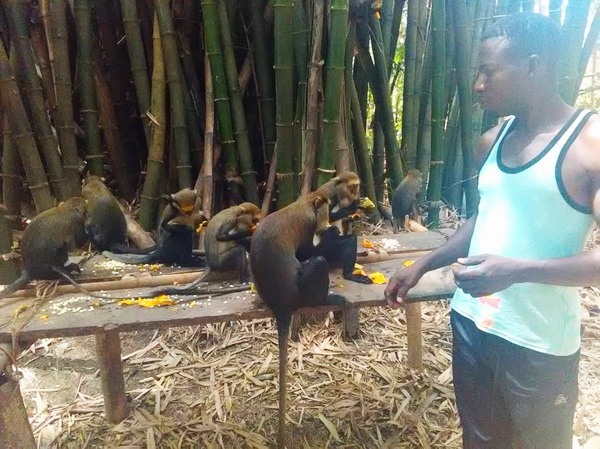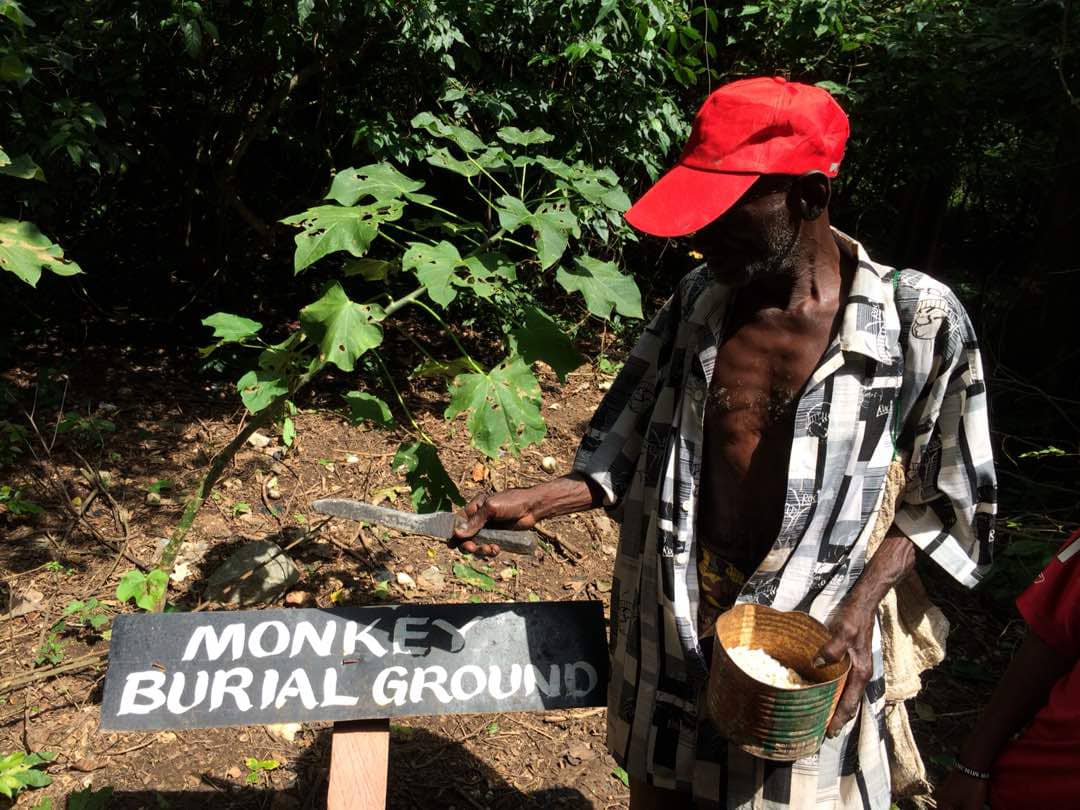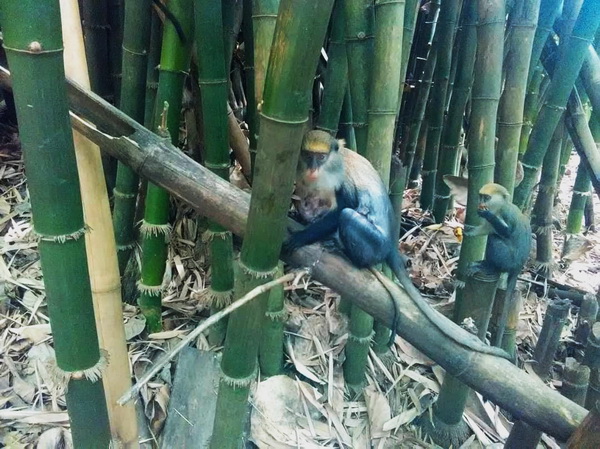
Visit Duasidan Monkey Sanctuary, where there’s a graveyard for dead monkeys
The mystery, myth, rich history, and uniqueness of the Duasidan Monkey Sanctuary in the Dormaa Central Municipality of the Bono Region of Ghana makes it arguably the best, if not one of the very best tourist sites in the country.
This is accentuated by one major feature – the site of its queer monkey burial ground.
Advertisement
Monkeys in this Sanctuary, part of a closed forest – are located near a sacred grove, where ancestral ceremonies and sacrifices are offered occasionally and holds the history behind the monkeys. The forest is host to three monkey species, namely, the Campbell Monkey or locally known as Kwakuo, Spot-nosed monkey or Ahenhema and Oliver Colobus monkeys or what’s locally known as Asibe.

Distance to Duasidan
Duasidan is nine kilometres away from Dormaa – Ahenkro, the municipal capital.
Visitors and observers who often patronise the site give an unusual reverence, good treatment and respect to the monkeys, just like you would for any other god/s. Same is extended to the natural vegetative cover which harbours various species of trees, bamboos and animals.
Local people still hold the belief that a person can lose his or her life for failing to respect the lives of these monkeys when they deliberately kill or cause injuries to them – whatever their intentions may be. There are grave and severe consequences or what is perceived to be the wrath of the gods is visited supernaturally in the form of strange chronic diseases, or culprits suffering deformities, especially those found guilty to have killed or injured a monkey at the Sanctuary. It will require ritual interventions and pacification of the gods for forgiveness and confession to reverse or revoke such self-incurred wrath.
Tour guide’s sentiments
Mr. Michael Adjei, a tour guide, remarks that one of the last things they would ever do is to allow hunters and inhabitants to hunt down the monkeys. It is completely forbidden. The inhabitants unanimously or collectively, gang up and chase individuals who flout directives not to kill these animals. The natives also hold these animals in high esteem and regard them so much. The monkeys at the Sanctuary bear funny local names such as ‘Abrewa’, an Akan word which translate to ‘an old woman’ and some foreign names such as Comfort, Vida.

Farming Community
Duasidan, is a small farming community with a population of about 200 people. It takes a 20-minute drive from the municipal capital to the community. Majority of the inhabitants are small holder farmers who cultivate cash crops such as cocoa, while others are petty traders.
Historically, the people of Duasidan trace their roots to Denkyira. They had first settled at Amasu. Their ancestor, then known as Nana Asiedu, was a hunter who used Duasidan as his hunting ground. He established his hunting camp under a fallen tree.
The tree provided him with excellent shelter whenever it was raining and as the tree functioned like a house, he named it Duasidan, to wit, “tree builds a house”. This is how the community came into existence.
Existence of caves
Another exciting and interesting feature to find at the place are its caves, which house a lot of animals notably, the crested porcupine.
A fetish priestess, then a sister to Nana Asiedu had proclaimed that the monkeys were the children of the land and had cautioned that nobody should harm or hunt them. The respect for this taboo is what has significantly contributed to preserving the place all these years. The sacred cave is sited at the grove.
It is not very clear how long the monkeys have been in Duasidan which itself is about four generations old.
Pipelines and taps are almost non–existent in the area. That said, it is not so difficult to find clean drinking water. You can even find and buy in the dusty street cold sachet or bottled water. Two boreholes are available to the entire community - one is broken down though. The functioning borehole remains a major source of drinking water for inhabitants of the community, and for all other activities.
Monkey-John
A few metres’ walk from the path that leads into the Sanctuary is a three-feet signpost showing the graveyard for the monkeys on your left-hand side. A monkey is buried there. It used to be call monkey–John. Shot dead three years ago by a hunter who was returning from a hunting expedition who incidentally had met the monkey foraging the beautiful forest.
Local legend has it that the killing of the monkey had sparked an outrage, angering and grieving the inhabitants who later mounted some hot chase for the hunter, however, they never would find him.
“Someone shot John. Others claim the person who shot the monkey, was a native of Duasidan, and later on became mad. We do not know the person’s whereabouts till today”, adds Nana Dinisa, the Chief of Duasidan.
It was later revealed to a fetish priest at Kofikumkrom that one of the children of the land had been wounded. The priest was demanding a bottle of palm oil to treat the wounds to avert any calamity.
The palm oil was provided and kept at the sacred site and peace was restored. It is said also that a man from Dormaa upon seeing the monkeys had remarked that he was going home for his gun to come and kill them. He fell sick when he got home. He swelled up and died. Till date anytime a monkey dies and the carcass is seen, it is given a fitting burial.
Monkeys at the sacred grove share very unique characteristics. They can wander from their point of location at Duasidan to Amasu which is more than 300 kilometres away, and return to location. They go as far as Pampaso, also in the municipality which is about 250 kilometres away and sometimes interact with inhabitants in such communities.
“If they are monkeys from the grove, at a call they invade homes and engage in playful activity with inhabitants there. But those that are not from the Sanctuary would not naturally respond to such calls,” the Chief stated.
Socio-economic prospects
Nevertheless, there is a huge prospect for socio-economic development of the area achievable by the development of its promising tourism sector. Several facilities at the Sanctuary, and infrastructure such as roads leading to the area remain in poor condition. Not much has been done by governments in terms of upgrading and providing facilities such as visitors’ information centre, summer huts, accommodation, guest houses, hotels or restaurants for those tourists who may want to visit the Sanctuary. This typically detracts from the facility as an ideal tourism destination for those who would like to go on long vacations.
Huge opportunities beckon the private sector, especially so as there are no immediate or palpable plans by any duty bearer to enhance the socio-economic development of the area. At best, any such plans are distant dreams.
Meet the press
At a Meet the Press event held recently, Mr. Drissa Ouattara, the Dormaa Central Municipal Chief Executive gave a clear indication that the development of the Sanctuary was in the plans of the Municipal Assembly. He didn’t specifically spell out exactly what the plans were or how they intend to execute that undisclosed plans.
And he was extremely brief, not giving too much detail, elaboration, focus and attention to that issue.
“It is in our plans,” he remarked briefly.
Joseph Appiagyei
Mr. Joseph Appiagyei, Acting Bono Regional Manager, Ghana Tourism Authority (GTA), revealed that a proposal which comprehensively details plans for a receptive facility and other infrastructure for the Sanctuary has been submitted and waiting for appropriate response and action from superiors in Accra.
In his view, the area’s strategic location by virtue of its proximity to Ivory Coast makes it necessary, vital and appropriate to upgrade it through value addition which would create synergies for the improvement of the local economy.
“We intend to carry out this initiative with the support and collaboration of local authorities”, he added.
Lawrence Kwame Antwi
Mr. Lawrence Kwame Antwi, immediate past Assembly Member, Yawkrom Electoral Area which also encompasses the Duasidan, had observed that during his tenure as a member of the Assembly, various budgetary allocations for the provision of a summer hut and other vital facilities were factored into the Assembly’s composite budgets.
“When we demanded from the Assembly why they were not giving attention to the development of the place although it has been captured in the budget, they said not all projects were executed under the composite budget.
Patronage
Patronage of the Sanctuary usually peaks during festive seasons – on Christmas, Easter, during the celebration of Kwafie Festival, celebrated by the chiefs and people of Dormaa to clean, sanitise and rid communities of filth. The festival celebration is also to resolve outstanding disputes between families and promotes peace in the spirit of neighbourliness.




